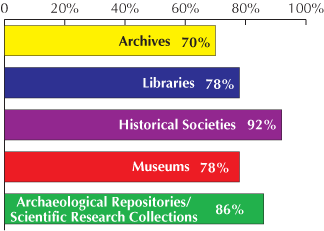In 2004, Heritage Preservation published the Heritage Health Index, a survey and report which highlighted, among other issues, an alarming set of statistics indicating a large percentage of heritage-related institutions in the United States lack a disaster plan for their collections.

Institutions with No Emergency Plan with Staff Trained to Carry It Out, Heritage Health Index 2004 http://www.heritagepreservation.org/HHI/data7.html
Since 2004, there has been a widespread outreach, education, and effort to improve these numbers. Sadly, the Heritage Preservation organization was dissolved in 2015 and we still await the results (if they are ever to be compiled) of the 2014 survey, but you can still put your institution’s best foot forward during the Bicentennial year by creating a plan of your own.
So what is a disaster plan for a collection, and what is the point of having one?
A disaster plan for a collection is a resource for institutions when part or all of a collection is damaged in some kind of event, whether it’s a small leak or a large-scale natural disaster. It is there to provide guidance after everyone is safe, you’re cleared by emergency services to reenter your building, and you see this:

Colorado State University’s (CSU) Morgan Library in Fort Collins, Colorado on July 28, 1997 http://cool.conservation-us.org/byauth/silverman/day/
YIKES! Okay, let’s do this!
Before you begin to write your plan, I highly recommend you view a webinar related to disaster planning and response, as it will absolutely open your mind up to many scenarios you might not have considered. After you’ve got an idea about what is ahead, you will need to evaluate your collections, your building, and what risks might be specific to your institution. Once you’ve got the lay of the land, so to speak, you can start your writing process. You can find several webinars online, but here are a few I’ve found for your reference:
Connecting to Collections Risk Evaluation: First Step in Disaster Planning
ALA Disaster Preparedness and Planning Webinar
As a result of all the outreach after the 2004 Heritage Health Index, there is a plethora of extremely helpful information online to make the process much easier, such as Heritage Preservation’s Risk Evaluation Guide and ALA’s Disaster Preparedness and Recovery site. You can also find many results online from many different institutions that have helpfully made their plans public. I also found help from my colleagues at both the Indiana Historical Society and Indiana University Bloomington Libraries Preservation, who allowed me to see their plans. I based the ISL plan very heavily on the IHS plan (with permission, of course), but tailored it to our specific needs. The common theme found during my research both online and from other institutions was that the most important things to remember are to keep it simple, accessible, and flexible.
Another tool your institution might want to consider is the Pocket Response Plan (PREP). The PREP, created by Council of State Archivists (CoSA), is a very basic pocket plan template that any institution can download and customize for free. You simply fill out the information as it pertains to your institution, print it on legal paper, and cut and fold it up to the size of a credit card so that it can be kept in a lanyard or wallet. It is meant to be a barebones addition to the full plan, but can still be immediately helpful to any institution that still lacks a plan.
Train, train, train!
Once you’re finished with your plan, don’t forget to train your staff on how to implement it! Inform your staff about where you’ll keep copies of the plan in your building, who the members of your response team are, what the expectations for staff members are, and how to use their pocket plans.
The ISL Collections Disaster Plan
The ISL plan consists of some preliminary information, such as what to do first, who to call, how to physically care for specific types of collections materials (books, maps, VHS tapes, paintings, etc), and site, vendor, and supplies lists. We have also paired a Pocket Response Plan (PREP) with the full plan so that all staff can carry an abridged form of the plan with them at all times. For reference purposes, we are joining other institutions in publishing our plan online. Please note: for privacy reasons, we have removed all contact details for staff members from this online version.
View the ISL Collections Disaster Plan (PDF)
Download a free Pocket Response Plan (PREP) template
We would like to thank the Indiana Historical Society Conservation Department and Indiana State University Libraries Preservation for assistance and examples provided that were adapted/utilized in the creation of the ISL Collections Disaster Plan. This blog post was written by Rebecca Shindel, Conservator, Indiana State Library.
